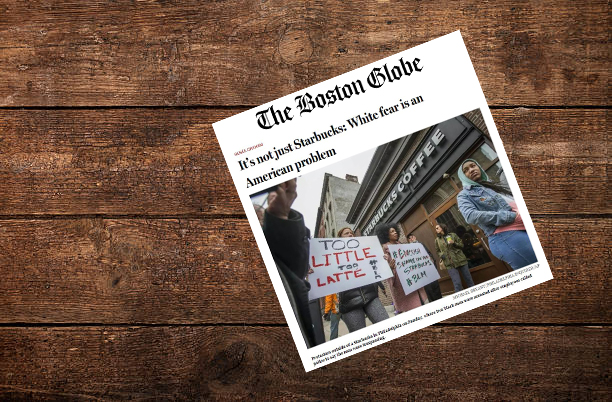Share This:
April 26, 2018 | Race and Equity,
White Fear

Renée Graham’s “White Fear is an American Problem” ran APRIL 16, 2018 in The Boston Globe
This article by Renee Graham in the Boston Globe last week shook me, hard: it explained, in direct and clear terms, something that I have intuitively felt in my own journey with ArtsEmerson’s vision but have struggled to articulate.
As Artistic Director, a large part of my job is to help express the ArtsEmerson vision through the public programming we present. The whole ArtsEmerson staff is deployed in a very intentional process of fostering opportunities to see, feel, and engage the reality of Boston as a multicultural, global city. We’re a city with no cultural majority, and it’s my responsibility here to propose a program that helps manifest that reality in our lived experience.
But we are also a city that is trapped in an outdated story about ourselves, the story of a white majority city with a history of segregation.
People have repeatedly questioned why I would focus so much of the programming and energy on the African American communities of Boston as we try to build the audience we need to achieve our mission. And I’ve answered by saying that, in terms of understanding (and advancing) the contemporary multicultural narrative of Boston, the fault-line is race. This is the same proposition underlying the Boston Globe’s Spotlight Series that prompted David Howse and me to author an Op Ed, and to start this series on ArtsEmerson’s blog.
The implication in the question “Why focus on black communities and artists?” is that there is not a large enough potential audience in black Boston to sustain all these shows we are programming that emanate from the African diaspora. At root, this question assumes the work that centers black stories is “for” black audiences.
Reading Renee Graham’s article, a lightbulb finally went off. I’ve never believed that the programming that was rooted in the African diaspora was exclusively (or even primarily) for black audiences but I didn’t seem to be able to articulate why in any way satisfied the questioners. Graham’s article finally gives me the words.
“White Fear.”
That’s the term Graham uses to describe the phenomenon driving the rash of terrible images in the news of these last two weeks, images that have been piling up for decades, now at an accelerating pace thanks to social media, dash cams, and the rise of the selfie and the citizen journalist. From a Philadelphia Starbucks, to a backyard in Sacramento, to a front porch in a Detroit suburb, to an Alabama Waffle House, to a Cambridge sidewalk, White Fear is in our faces right now in inescapable ways.
Claudia Rankine’s The White Card confronts us with the notion that white people in America have never seen black people as fully human. We are controlled, she says, by a racial imagination. We do not see the person in front of us because we are seeing, first, a projection of our imagination. Graham narrows that down for us: it is a projection that provokes fear.
Graham’s article concludes “Nothing will ever change until a majority of white people in this nation stop perceiving black existence as sinister and suspicious. Talking about racism may hurt white people’s feelings, but their unchecked racism continues to endanger our black lives.”
And here is where my work with ArtsEmerson intersects her argument. An antidote for this condition of White Fear, I believe, is more – and different – interactions with blackness. My desire is that the shows on our stages are offering these opportunities in spaces that allow for reflection, for connection, for discussion and perspective taking. We talk, at ArtsEmerson, of fostering civic transformation that leads to a thriving world. Daniel Beaty, our resident artist, has shown us that what precedes this vision of a transformed city has to begin first with our own personal transformation, which builds to transformed communities which, then and only then, result in transformed cities.
So, yes, I always hope my African American neighbors and colleagues will feel at home in our spaces and in our programming. But I also want our spaces and our programming to foster conditions that allow these same people to feel safe and welcome in our shared city. And that means that I have to work from the awareness that a large part of what’s putting my neighbors in danger in their own communities is the fear that lurks in my own conditioned imagination and in those of my white neighbors.
It is my hope that, in carrying out my responsibilities as Artistic Director, I am offering into the mix a range of stories, forms, and voices that challenge, and help to heal from, that conditioned response. Hopefully, the remedy being delivered by programming multiple narratives of the African diaspora is as much for me as for anyone. The malady it seeks to heal is the one diagnosed by Graham: White Fear.





Leave a Reply